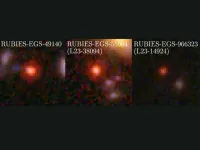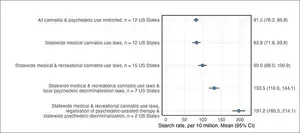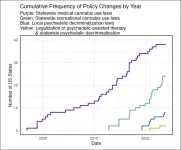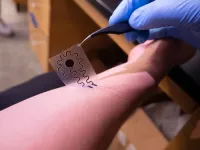(Press-News.org) UNIVERSITY PARK, Pa. — A recent discovery by NASA’s James Webb Space Telescope (JWST) confirmed that luminous, very red objects previously detected in the early universe upend conventional thinking about the origins and evolution of galaxies and their supermassive black holes.
An international team, led by Penn State researchers, using the NIRSpec instrument aboard JWST as part of the RUBIES survey identified three mysterious objects in the early universe, about 600-800 million years after the Big Bang, when the universe was only 5% of its current age. They announced the discovery today (June 27) in Astrophysical Journal Letters.
The team studied spectral measurements, or intensity of different wavelengths of light emitted from the objects. Their analysis found signatures of “old” stars, hundreds of millions of years old, far older than expected in a young universe.
The researchers said they were also surprised to discover signatures of huge supermassive black holes in the same objects, estimating that they are 100 to 1,000 times more massive than the supermassive black hole in our own Milky Way. Neither of these are expected in current models of galaxy growth and supermassive black hole formation, which expect galaxies and their black holes to grow together over billions of years of cosmic history.
“We have confirmed that these appear to be packed with ancient stars — hundreds of millions of years old — in a universe that is only 600-800 million years old. Remarkably, these objects hold the record for the earliest signatures of old starlight,” said Bingjie Wang, a postdoctoral scholar at Penn State and lead author on the paper. “It was totally unexpected to find old stars in a very young universe. The standard models of cosmology and galaxy formation have been incredibly successful, yet, these luminous objects do not quite fit comfortably into those theories.”
The researchers first spotted the massive objects in July of 2022, when the initial dataset was released from JWST. The team published a paper in Nature several months later announcing the objects’ existence.
At the time, the researchers suspected the objects were galaxies, but followed up their analysis by taking spectra to better understand the true distances of the objects, as well as the sources powering their immense light.
The researchers then used the new data to draw a clearer picture of what the galaxies looked like and what was inside of them. Not only did the team confirm that the objects were indeed galaxies near the beginning of time, but they also found evidence of surprisingly large supermassive black holes and a surprisingly old population of stars.
“It’s very confusing,” said Joel Leja, assistant professor of astronomy and astrophysics at Penn State and co-author on both papers. “You can make this uncomfortably fit in our current model of the universe, but only if we evoke some exotic, insanely rapid formation at the beginning of time. This is, without a doubt, the most peculiar and interesting set of objects I've seen in my career.”
The JWST is equipped with infrared-sensing instruments capable of detecting light that was emitted by the most ancient stars and galaxies. Essentially, the telescope allows scientists to see back in time roughly 13.5 billion years, near the beginning of the universe as we know it, Leja said.
One challenge to analyzing ancient light is that it can be hard to differentiate between the types of objects that could have emitted the light. In the case of these early objects, they have clear characteristics of both supermassive black holes and old stars. However, Wang explained, it’s not yet clear how much of the observed light comes from each – meaning these could be early galaxies that are unexpectedly old and more massive even than our own Milky Way, forming far earlier than models predict, or they could be more normal-mass galaxies with “overmassive” black holes, roughly 100 to 1,000 times more massive than such a galaxy would have today.
“Distinguishing between light from material falling into a black hole and light emitted from stars in these tiny, distant objects is challenging,” Wang said. “That inability to tell the difference in the current dataset leaves ample room for interpretation of these intriguing objects. Honestly, it’s thrilling to have so much of this mystery left to figure out.”
Aside from their unexplainable mass and age, if part of the light is indeed from supermassive black holes, then they also aren't normal supermassive black holes. They produce far more ultraviolet photons than expected, and similar objects studied with other instruments lack the characteristic signatures of supermassive black holes, such as hot dust and bright X-ray emission. But maybe the most surprising thing, the researchers said, is how massive they seem to be.
“Normally supermassive black holes are paired with galaxies,” Leja said. “They grow up together and go through all their major life experiences together. But here, we have a fully formed adult black hole living inside of what should be a baby galaxy. That doesn't really make sense, because these things should grow together, or at least that’s what we thought.”
The researchers were also perplexed by the incredibly small sizes of these systems, only a few hundred light years across, roughly 1,000 times smaller than our own Milky Way. The stars are approximately as numerous as in our own Milky Way galaxy — with somewhere between 10 billion and 1 trillion stars — but contained within a volume 1,000 times smaller than the Milky Way.
Leja explained that if you took the Milky Way and compressed it to the size of the galaxies they found, the nearest star would almost be in our solar system. The supermassive black hole in the center of the Milky Way, about 26,000 light years away, would only be about 26 light years away from Earth and visible in the sky as a giant pillar of light.
“These early galaxies would be so dense with stars — stars that must have formed in a way we've never seen, under conditions we would never expect during a period in which we’d never expect to see them,” Leja said. “And for whatever reason, the universe stopped making objects like these after just a couple of billion years. They are unique to the early universe.”
The researchers are hoping to follow up with more observations, which they said could help explain some of the objects’ mysteries. They plan to take deeper spectra by pointing the telescope at the objects for prolonged periods of time, which will help disentangle emission from stars and the potential supermassive black hole by identifying the specific absorption signatures that would be present in each.
“There's another way that we could have a breakthrough, and that's just the right idea,” Leja said. “We have all these puzzle pieces and they only fit if we ignore the fact that some of them are breaking. This problem is amenable to a stroke of genius that has so far eluded us, all of our collaborators and the entire scientific community.”
Wang and Leja received funding from NASA’s General Observers program. The research was also supported by the International Space Science Institute in Bern. The work is based in part on observations made with the NASA/ESA/CSA James Webb Space Telescope. Computations for the research were performed on Penn State’s Institute for Computational and Data Sciences’ Roar supercomputer.
Other co-authors on the paper are Anna de Graaff of the Max-Planck-Institut für Astronomie in Germany; Gabriel Brammer of the Cosmic Dawn Center and Niels Bohr Institute; Andrea Weibel and Pascal Oesch of the University of Geneva; Nikko Cleri, Michaela Hirschmann, Pieter van Dokkum and Rohan Naidu of Yale University; Ivo Labbé of Stanford University; Jorryt Matthee and Jenny Greene of Princeton University; Ian McConachie and Rachel Bezanson of the University of Pittsburgh; Josephine Baggen of Texas A&M University; Katherine Suess of the Observatoire de Sauverny in Switzerland; David Setton of Massachusetts Institute of Technology’s Kavli Institute for Astrophysics and Space Research; Erica Nelson of the University of Colorado; Christina Williams of the U.S. National Science Foundation’s National Optical-Infrared Astronomy Research Laboratory and the University of Arizona.
END
Tiny bright objects discovered at dawn of universe baffle scientists
2024-06-28
ELSE PRESS RELEASES FROM THIS DATE:
Study shows corporate social misbehavior hurts brands
2024-06-28
In today's interconnected world, the actions of corporations can have far-reaching consequences. A new study, co-authored by two University of Akron (UA) faculty and published in the top ranked international business journal Global Strategy Journal, reveals that incident of corporate social irresponsibility (CSI) — like pollution, corruption, discrimination, or poor labor conditions in supply chains — significantly damage brand reputation and international sales growth.
Over nine years and across 109 countries, researchers tracked the performance of 335 company branches alongside reported CSI incidents involving their parent companies. The results clearly ...
Creating supranormal hearing in mice
2024-06-28
A study from Michigan Medicine's Kresge Hearing Research Institute was able to produce supranormal hearing in mice, while also supporting a hypothesis on the cause of hidden hearing loss in humans.
The researchers had previously used similar methods—increasing the amount of the neurotrophic factor neurotrophin-3 in the inner ear—to promote the recovery of auditory responses in mice that had experienced acoustic trauma, and to improve hearing in middle-aged mice.
This study is the first to use the same approach in otherwise healthy young mice to ...
Most Americans don’t know that primary care physicians can prescribe addiction treatment
2024-06-28
Results from a national survey indicate that many Americans, 61%, are unaware that primary care physicians can prescribe medications for opioid use disorder, and 13% incorrectly believed that they could not. The survey, funded by the National Institutes of Health (NIH), also found that 82% of the people who reported ever misusing prescription or illicit opioids expressed comfort in going to their primary care physicians for medications for opioid use disorder. Among those who had not misused opioids, a majority, 74%, reported they would ...
Heritability of body mass index among familial generations
2024-06-28
About The Study: In this study, the weight status of parents at 17 years of age was associated with obesity risk for both female and male offspring, emphasizing that parental factors may influence the next generation’s health outcomes.
Corresponding Author: To contact the corresponding author, Gabriel Chodick, Ph.D., email chodick@tauex.tau.ac.il.
To access the embargoed study: Visit our For The Media website at this link https://media.jamanetwork.com/
(doi:10.1001/jamanetworkopen.2024.19029)
Editor’s Note: Please ...
Source-specific air pollution and loss of independence in older adults across the US
2024-06-28
About The Study: This study found that long-term exposure to air pollution was associated with the need for help for lost independence in later life, with especially large and consistent increases in risk for pollution generated by traffic-related sources. These findings suggest that controlling air pollution could be associated with diversion or delay of the need for care and prolonged ability to live independently.
Corresponding Author: To contact the corresponding author, Boya Zhang, Ph.D., email zhboya@umich.edu.
To ...
As restrictions on cannabis and psychedelics ease, Americans dabble with ‘microdosing’
2024-06-28
Loosening local, state and federal regulations on cannabis and psychedelics has increased Americans' interest in microdosing, according to a study from researchers at the University of California San Diego. Published in JAMA Health Forum, the study found that the rate of microdosing-related Google searches grew by 1250% from 2015 to 2023, with over three million searches in 2023 alone. This surge in interest correlates with recent legislative changes decriminalizing or authorizing the use of psychedelic substances in therapy and permitting ...
Soft, stretchy electrode simulates touch sensations using electrical signals
2024-06-28
A team of researchers led by the University of California San Diego has developed a soft, stretchy electronic device capable of simulating the feeling of pressure or vibration when worn on the skin. This device, reported in a paper published in Science Robotics, represents a step towards creating haptic technologies that can reproduce a more varied and realistic range of touch sensations.
The device consists of a soft, stretchable electrode attached to a silicone patch. It can be worn like a sticker ...
Undergrad's Crohn's discovery could lead to better treatments for devastating condition
2024-06-28
Remarkable new research by a University of Virginia undergraduate may help explain recurrent Crohn’s disease in children and open the door to new ways to treat or even cure the devastating condition.
Crohn’s is a debilitating – and possibly life-threatening – inflammation of the digestive tract. Symptoms include abdominal pain, weakness, fatigue and malnutrition caused by the body’s inability to absorb nutrients. It’s most common in adults but afflicts tens of thousands of children in the United States alone. Many of those ...
Pilot study shows promise for remote cognitive rehabilitation for multiple sclerosis
2024-06-28
East Hanover, NJ – June 28, 2024 – A pilot study shows promise for a new treatment option for individuals with memory impairments caused by multiple sclerosis (MS). The article, “Exploring the efficacy of a remote strategy-based intervention for people with multiple sclerosis with everyday memory impairments: A pilot study,” (doi: 10.5014/ajot.2024.050468) was published online on May 27, 2024, in the American Journal of Occupational Therapy.
This proof-of-concept study, conducted in ten participants ...
New model could help provide expectant mothers a clearer path to safe fish consumption
2024-06-28
Fish consumption during pregnancy is a complex scientific topic. On one hand, fish are rich in nutrients essential to brain development, including polyunsaturated fatty acids, selenium, iodine, and vitamin D. On the other, fish contain methyl mercury, a known neurotoxicant. This has led the US Food and Drug Administration to recommend that expectant mothers limit consumption, which inadvertently causes many women to forgo fish consumption during pregnancy altogether.
Fish consumption is an important route of methyl mercury exposure, however, efforts to understand the health risk posed by mercury are further complicated by the fact that the nutritional ...





